Serving 550 students in grades Prekindergarten-5, Walter S. Mills - Parole Elementary School ranks in the bottom 50% of all schools in Maryland for overall test scores (math proficiency is bottom 50%, and reading proficiency is bottom 50%).
The percentage of students achieving proficiency in math is 6% (which is lower than the Maryland state average of 25%). The percentage of students achieving proficiency in reading/language arts is 17% (which is lower than the Maryland state average of 45%).
The student:teacher ratio of 10:1 is lower than the Maryland state level of 14:1.
Minority enrollment is 97% of the student body (majority Hispanic), which is higher than the Maryland state average of 68% (majority Black and Hispanic).
Quick Stats (2025)
- Grades: Prekindergarten-5
- Enrollment: 550 students
- Student:Teacher Ratio: 10:1
- Minority Enrollment: 97%
- Overall Testing Rank: Bottom 50% in MD
- Math Proficiency: 6% (Btm 50%)
- Reading Proficiency: 17% (Btm 50%)
- Science Proficiency: 6-9% (Btm 50%)
- Source: National Center for Education Statistics (NCES), MD Dept. of Education
Top Rankings
Walter S. Mills - Parole Elementary School ranks among the top 20% of public schools in Maryland for:
Category
Attribute
Percent Eligible For Free Lunch
Student Attention
School Overview
Walter S. Mills - Parole Elementary School's student population of 550 students has declined by 7% over five school years.
The teacher population of 56 teachers has grown by 12% over five school years.
Grades Offered
Grades Prekindergarten-5
(offers virtual instruction)
(offers virtual instruction)
Total Students
550 students
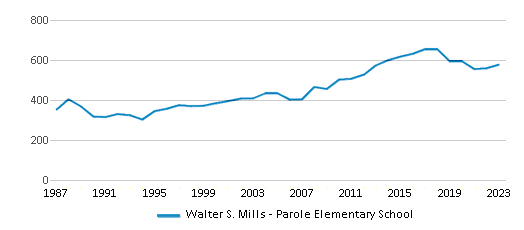
Gender %
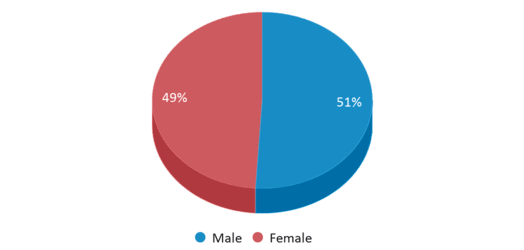
Total Classroom Teachers
56 teachers
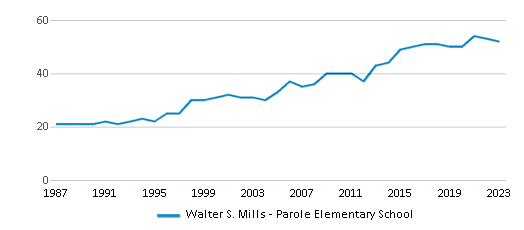
Students by Grade
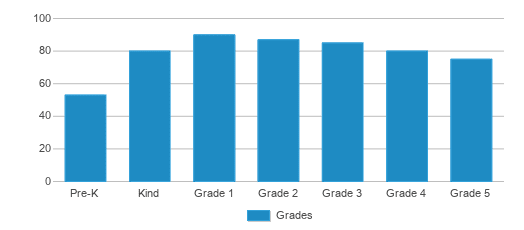
School Rankings
Walter S. Mills - Parole Elementary School ranks within the bottom 50% of all 1,347 schools in Maryland (based off of combined math and reading proficiency testing data).
The diversity score of Walter S. Mills - Parole Elementary School is 0.53, which is less than the diversity score at state average of 0.74. The school's diversity has stayed relatively flat over five school years.
Overall Testing Rank
#1217 out of 1347 schools
(Bottom 50%)
(Bottom 50%)
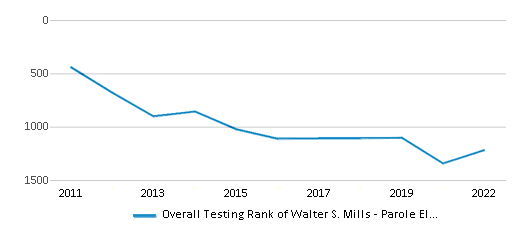
Math Test Scores (% Proficient)
6%
25%
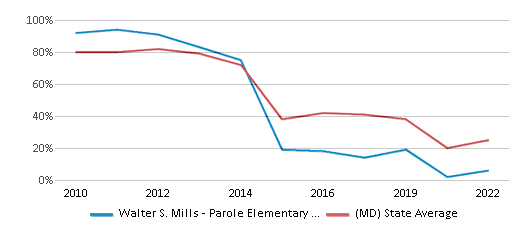
Reading/Language Arts Test Scores (% Proficient)
17%
45%
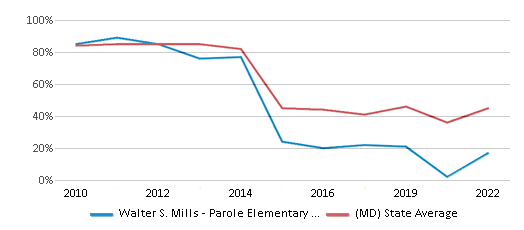
Science Test Scores (% Proficient)
6-9%
36%
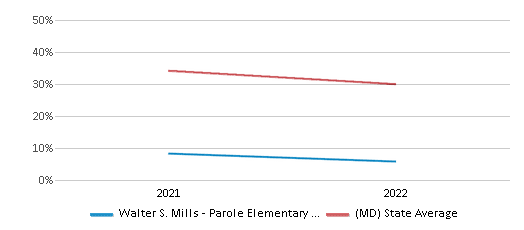
Student : Teacher Ratio
10:1
14:1
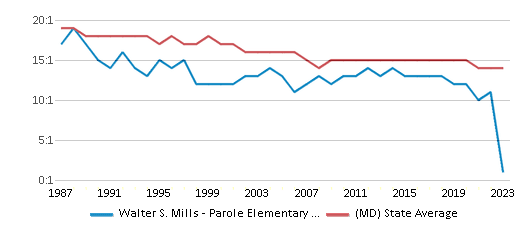
American Indian
n/a
n/a
Asian
1%
7%
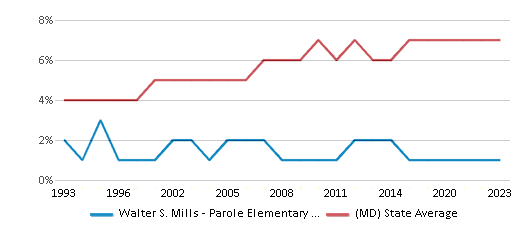
Hispanic
58%
23%
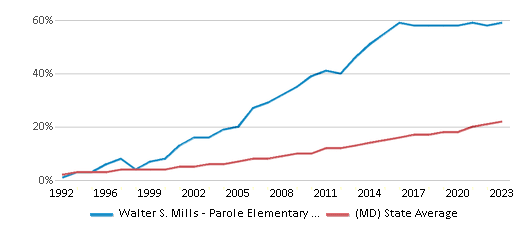
Black
37%
33%
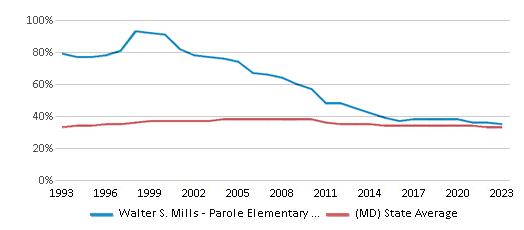
White
3%
32%
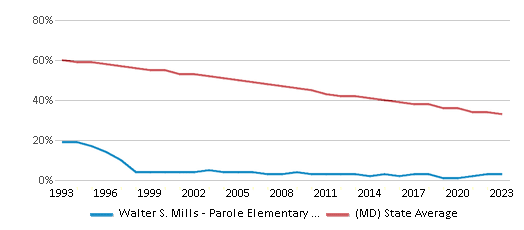
Hawaiian
n/a
n/a
Two or more races
1%
5%
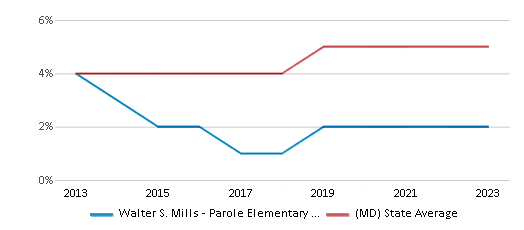
All Ethnic Groups
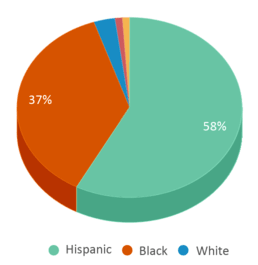
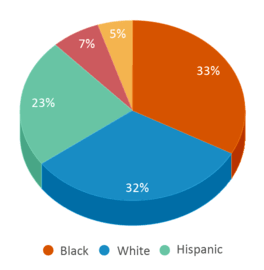
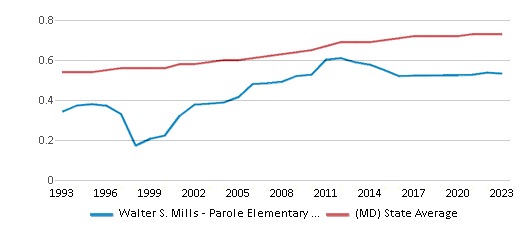
Participates in the National School Lunch Program (NSLP)
Yes
Eligible for Free Lunch
82%
44%
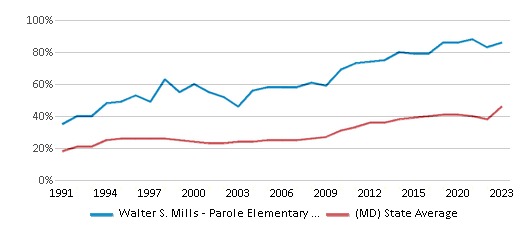
Eligible for Reduced Lunch
12%
5%
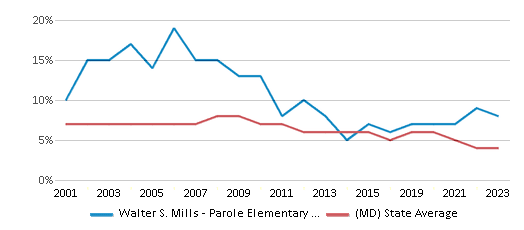
School Statewide Testing
School District Name
Source: National Center for Education Statistics (NCES), MD Dept. of Education
Profile last updated: 02/09/2025
Frequently Asked Questions
What is Walter S. Mills - Parole Elementary School's ranking?
Walter S. Mills - Parole Elementary School is ranked #1217 out of 1,347 schools, which ranks it among the bottom 50% of public schools in Maryland.
What schools are Walter S. Mills - Parole Elementary School often compared to?
Walter S. Mills - Parole Elementary Schoolis often viewed alongside schools like Germantown Elementary School, Georgetown East Elementary School by visitors of our site.
What percent of students have achieved state testing proficiency in math and reading?
6% of students have achieved math proficiency (compared to the 25% MD state average), while 17% of students have achieved reading proficiency (compared to the 45% MD state average).
How many students attend Walter S. Mills - Parole Elementary School?
550 students attend Walter S. Mills - Parole Elementary School.
What is the racial composition of the student body?
58% of Walter S. Mills - Parole Elementary School students are Hispanic, 37% of students are Black, 3% of students are White, 1% of students are Asian, and 1% of students are Two or more races.
What is the student:teacher ratio of Walter S. Mills - Parole Elementary School?
Walter S. Mills - Parole Elementary School has a student ration of 10:1, which is lower than the Maryland state average of 14:1.
What grades does Walter S. Mills - Parole Elementary School offer ?
Walter S. Mills - Parole Elementary School offers enrollment in grades Prekindergarten-5 (offers virtual instruction).
What school district is Walter S. Mills - Parole Elementary School part of?
Walter S. Mills - Parole Elementary School is part of Anne Arundel County School District.
School Reviews
5 2/26/2016
I am an alumni and now a grandparent of a student attending. I love Mills Parole and Mrs. Sue Myers. She is 100 supportive of the students both in the school and outside of the school and the teachers are very caring. My granddaughter is extremely advanced and they take the time to give her extra work so she doesn't get bored. I love that anytime my daughter has a question she can text/email the teacher and get immediate results.
5 8/20/2012
I LOVE THIS SCHOOL I GO TO THIS SCHOOL IM YESLI MENJIVAR I FEEL SAFE AT THIS SCHOOL ITS LIKE IF IT WAS MY HOME MRS.ADAMS AND MRS.HENDERSON ARE THE BEST WHEN EVER U NEED SOME ONE THEY WILL BE THERE FOR U CAUSE WE ARE KIDS AT HOPE I LOVE MILLS PAROLE ITS THE BEST PLACE TO BE
2 4/4/2011
I would not go! My child disliked it very strongly and the uniforms are a negative and i found the teachers to be very un professinal
Review Walter S. Mills - Parole Elementary School. Reviews should be a few sentences in length. Please include any comments on:
- Quality of academic programs, teachers, and facilities
- Availability of music, art, sports and other extracurricular activities
Recent Articles

What Is A Charter School?
Explore the world of charter schools in this comprehensive guide. Learn about their history, how they operate, and the pros and cons of this educational innovation. Discover key facts about charter schools, including admission policies, demographics, and funding, as well as what to look for when considering a charter school for your child.

10 Reasons Why High School Sports Benefit Students
Discover the 10 compelling reasons why high school sports are beneficial for students. This comprehensive article explores how athletics enhance academic performance, foster personal growth, and develop crucial life skills. From improved fitness and time management to leadership development and community representation, learn why participating in high school sports can be a game-changer for students' overall success and well-being.

February 05, 2025
Understanding the U.S. Department of Education: Structure, Impact, and EvolutionWe explore how the Department of Education shapes American education, from its cabinet-level leadership to its impact on millions of students, written for general audiences seeking clarity on this vital institution.





